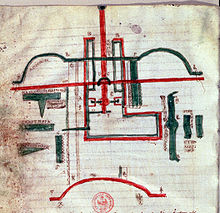Gastraphetes
The Gastraphetes ( Greek γαστραφέτης "belly slingshot") was a Greek infantry weapon . It is one of the ancient forerunners of the later crossbow .
Description and use

We know of the appearance and handling of the Gastraphetes since the Greek engineer Heron of Alexandria in the 3rd century BC. BC recorded a detailed plan of the weapon that has survived to this day. This weapon was the first historically documented crossbow-like hand weapon outside of ancient China. It was a composite bow mounted on a wooden shaft. In contrast to the later crossbow, however, the shaft of the Gastraphetes had another longitudinally movable wooden rail. The arch and the curved rear wooden part were attached to the lower part of the shaft, while the movable upper rail was used for tensioning. To do this, you pushed it forward and hung the string. Then you put the protruding end of the rail on the floor and put the rear support on your upper body. The archer could now push the wooden rail back by pressing downwards until it clicked into a holding mechanism with the string. Now an arrow could be inserted and the shot triggered. Due to the tensioning technique and the holding mechanism, considerably more force could be used to tension the gastraphetes than was the case with archers. Therefore, longer ranges and greater penetration were possible.
There are also accounts of ancient writers telling of Gastraphetes who could shoot two arrows at once. There were two indentations for the arrows in the upper rail. According to some authors, the gastraphetes required a supporting device due to their size, e.g. B. a stake in the ground.
In addition, due to the complex mechanism, the weapon was both significantly more complex to manufacture and considerably heavier than conventional bows. Therefore it was not widely used as an infantry weapon .
history
The Gastraphetes was founded in the 4th century BC. Invented in Greece. Because of the reasons mentioned above, however, it was never particularly important in ancient times. It was sometimes used in the Roman army , but only when defending camps; v. a. if one had to wait for the enemy, the gastraphetes had the advantage of not requiring any further strength to keep the tension. The portable crossbow only became important after the fall of the Western Roman Empire : an improved (and lighter) model of the gastraphetes was introduced into the Eastern Roman armed forces. The crossbow as such became popular in the Middle Ages and was also widely used in Byzantium .
literature
- Peter Connolly : The Greek Armies. Tesslofverlag, Hamburg 1981, ISBN 3-7886-0181-7 .
- Astrid Schürmann: Greek mechanics and ancient society. Studies for the state promotion of a technical science. Verlag Steiner, Stuttgart 1991, ISBN 3-515-05853-2 ( Boethius 27).
Web links
- Roberto Sconfienza, Fabrizio Zannoni, work on historical siege weapons, gastraphetes at Archeofortificazioni ( Memento from May 17, 2005 in the Internet Archive )
- Gastraphetes at Mlahanas
Individual evidence
- ^ Astrid Schürmann: Greek mechanics and ancient society. Verlag Steiner, 1991, ISBN 978-3-515-05853-7 , p. 66.
- ^ Duncan Campbell: Greek and Roman Artillery 399 BC – AD 363. Oxford: Osprey Publishing, 2003, ISBN 1-84176-634-8 , pp. 3 ff.

